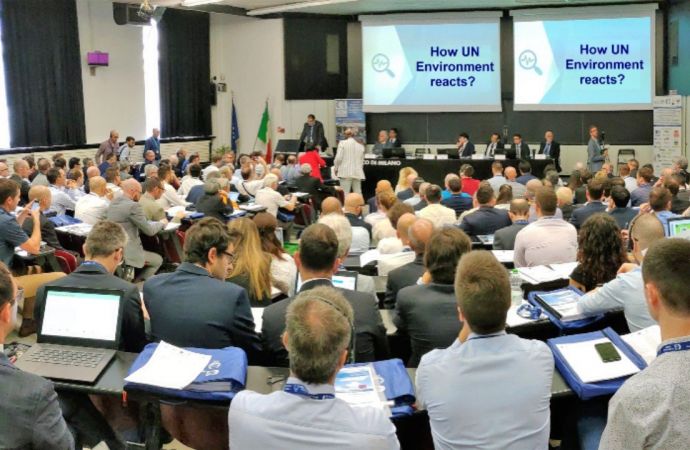Four of the five winning projects in the ASHRAE-UNEP 2019 Innovation Awards – designed for developing countries – involve natural refrigerants.

National Ozone Unit representatives from the winning regions accept certificates on behalf of the selected projects at an ASHRAE-UNEP side event held during MOP31.
ASHRAE and the UN Environment Programme (UNEP) yesterday announced the project selections for the 2019 OzonAction Lower-GWP Refrigeration and Air-Conditioning Innovation Awards. Out of the five winning projects, four included natural refrigerants.
The projects were recognized at an ASHRAE UNEP side event held during the 31st Meeting of the Parties to the Montreal Protocol on Substances that Deplete the Ozone Layer (MOP31) in Rome.
This annual international award program promotes innovative design, research and practice by recognizing people who have developed or implemented innovative technological concepts applied in developing countries to promote lower GWP refrigerants through refrigeration and air-conditioning applications.
“The projects selected represent long-term, global and energy efficient solutions to lessen the impact of ozone depleting substances,” said Sheila J. Hayter, ASHRAE President and co-chair of the judging committee. “We congratulate the selected project teams and look forward to witnessing their innovative concepts set a benchmark for sustainability in developing countries.”
The projects in each category were selected based on delivering innovative solutions to meet refrigeration and air-conditioning needs by using lower-GWP technologies. Five projects were selected in two categories: Residential Applications (one natural refrigerants winner) and Commercial/Industrial Applications (three natural refrigerants winners).
And the winners are…
Residential:
- A low-charge ammonia vapor compression refrigeration system for residential air-conditioning implemented in India: “This project was envisaged to develop a 3TR (10.6kW) ammonia vapor-compression refrigeration system for residential air conditioning and to analyze the minimum possible charge to reduce leakage hazards associated with the system,” said the announcement. Project Team: Rajesh Kumar N, D. Mohan Lal and Kamalakannan.
- HFC-161 application technology development for high cooling capacity household air conditioners implemented in China: “The central objective of the project was to develop a household air-conditioning system with a large cooling capacity that replaced the use of HCFC-22 for HFC-161 as a refrigerant. The project provides solutions to the high use of HCFC-22 in China through replacement technologies that meet the latest environmental protection requirements for the domestic household air-conditioning industry. HFC-161, with ODP value of 0 and GWP value of 4, can be one of the solutions to comply with the HCFC phase-out commitments while leapfrog the use of higher GWP alternatives in line with the Kigali Amendment,” said the announcement. Project Team: Zhang Jianjun, Guo Zhikai, Zhang Lei, Zhang Mingjie and Xie Pinzan.
Commercial/Industrial:
- Packaged chillers with integrated air handling units using R32 and R290 implemented in Saudi Arabia: “The main goal for this project was to develop, design, manufacture and test a new large cooling capacity packaged air-conditioner (packaged chiller with integrated air handling unit) with a cooling capacity of 40, 70 and 100kW (11.4, 19.9 and 28.4TR) respectively, using low-GWP refrigerants (A3 and A2L) at standard and high ambient temperature conditions,” said the announcement. Project Team: Samir Hamed Alfetiany, Husam Quedan, and Samer Hamed Alfetiany.
- The crocodile project CO2 transcritical refrigeration system for a hot-and-humid region implemented in Thailand: “This project consists of two parts: refrigeration and extraction. The refrigeration part is for the office building’s air-conditioning system. It produces ice in the ice bank only at night, and the chilled water derived from this is pumped to serve the air-conditioners during the daytime,” said the announcement. Project Team: Warot Lamlertpongpana, Wallop Lamlertpongpana, Jittakorn Sukjareon, and Kittitach Chumnarnwat.
- Low charge propane chiller for a supermarket commercial refrigeration system implemented in Brazil: “The goal of this project was to develop a natural refrigerant refrigeration system to use in supermarkets. The propane chiller cools a secondary fluid, glycol, which is then used to cool medium-temperature cabinets and cold rooms. For low-temperature cabinets and cold rooms, CO2 is condensed by the same glycol (subcritical system),” said the announcement. Project Team: Rogério Marson Rodrigues, Ivair Lucio Soares Junior, Gustavo Galdi Heidinger, Cassio Lucio Simonetti, and Edgard Soares Pinto Neto.
The judges who reviewed the entries were Nesreene Ghaddar (Lebanon), Stephen Gill (U.K.), Roberto Peixoto (Brazil) and James Wolf (U.S.).
Projects will be showcased at respective OzonAction Network meetings and at the ASHRAE Winter Conference in Orlando, Fla., USA, February 1-5, 2020.
Related stories



